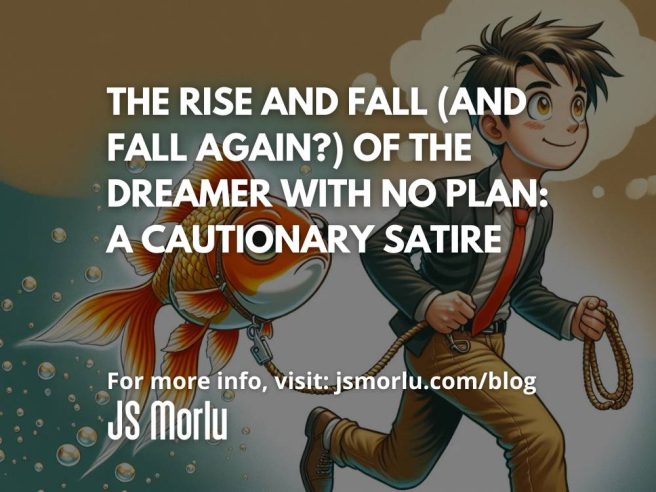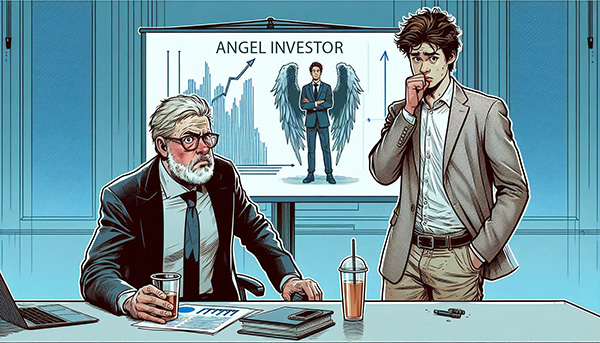By: John S. Morlu II, CPA
Picture this: a young entrepreneur with a wild gleam in his eye, an idea so revolutionary it could change the world—at least, that’s what he thought. His friends were inspired, his family was skeptical, and the goldfish he occasionally walked on a leash remained unimpressed. But the entrepreneur didn’t care. He was certain his startup idea would be the next big thing. Investors would line up, his name would become synonymous with innovation, and his app would be installed on every phone in the country.
Enter Bob: the dreamer, the visionary, and, if we’re being honest, the guy who forgot that the world doesn’t run on enthusiasm alone. You see, Bob was convinced his app, Feelr, would change the way people expressed their emotions. Why text your feelings when an app could broadcast them live to the world? It was perfect—genius, even. Except for one tiny problem: Bob had zero paying customers, no financial plan, and the cold, hard reality of the business world was about to slap him in the face.
Investors didn’t swoon over his pitch. Angel investors gave him polite nods, venture capitalists made vague promises, and even incubators offered him coffee instead of funding. Soon, Bob realized that bringing a big idea to life requires more than just a good story and passion. It requires money, a solid financial model, and an understanding of terms like “working capital ratio,” “EBITDA margin,” and “interest coverage.” Unfortunately, Bob had only been focused on the feels, not the funds.
What follows is a tale of relentless enthusiasm, harsh financial reality, and a crash course in what happens when you don’t do your homework before asking for a pile of money. With a touch of satire, a sprinkle of financial wisdom, and a whole lot of humor, we’ll dive into Bob’s journey from clueless dreamer to savvy business owner. Spoiler alert: things get messy, there’s plenty of rejection, and yes—Bob’s goldfish makes an appearance. Ready for a wild ride through the ups and downs of startup life? Buckle up, because Bob’s about to learn that running a business is more than just feelings.
Chapter 1: The Quest for Funding: Where Bob Gets a Reality Check
With stars in his eyes and a goldfish that was mildly annoyed at being walked around the block again, Bob set out on his journey to acquire the most sacred of startup necessities: funding. After all, what startup could exist without it?
Armed with a PowerPoint presentation featuring pie charts, stock photos of happy people, and some buzzwords he heard on a podcast, Bob marched into his first meeting with an angel investor.
“Hi, I’m Bob, and Feelr is going to revolutionize human interaction by telling everyone how they feel, in real time, using our patented Mood-o-meter™ technology.”
The angel investor, a bespectacled fellow in a trendy turtleneck, stared at Bob over his soy macchiato. “Sounds… interesting. Do you have any customers? Any revenue?”
Bob blinked. “Oh, no. But everyone will want this. We’ve done focus groups—well, not officially—but my mom and three of my college friends think it’s a winner.”
The investor smiled politely, the way you smile at a toddler who just tried to make a macaroni art masterpiece but really just made a mess. “Come back when you have some traction.”
Ah, traction. The word that haunts startup founders like Bob. What was traction, anyway? Was it the number of times he could slip the word “disruptive” into a sentence? (Answer: 3). Was it the amount of money in his bank account? (Nope. That would have been far too easy, and his account had $6.57 at the time, so he didn’t want to think about it).
Bob didn’t let this minor setback deter him. He continued his quest, pitching Feelr to venture capitalists, accelerators, incubators, and even a guy he met at Starbucks who seemed like he might know a guy who knew a guy in finance. But the answer was always the same: “Come back when you have traction.”
Bob was beginning to think “traction” was a code word for “go away.”
Chapter 2: Enter the Bank: Bob’s Crash Course in Financial Adulting
After his 37th rejection, Bob had a revelation. Sure, investors might not be interested yet, but banks were always looking to help out small businesses, right? After all, that’s what all those commercials with smiling bakers and dog groomers said. He could just get an SBA-backed loan! It was foolproof!
With renewed hope, Bob strutted into his local bank, where a stern-looking banker named Mr. Whittles greeted him with the enthusiasm of a man who had spent the last 20 years saying “no” for a living.
Bob slapped his business plan on the desk. “I’m here to apply for a loan,” he declared, beaming. “For my app. It’s called Feelr. It detects people’s emotions and broadcasts them. It’s going to change the world.”
Mr. Whittles raised an eyebrow. “Interesting. Let’s start with your credit score.”
Bob hesitated. “It’s fine. I mean, probably. I don’t really check it much, but I think it’s above 500?”
Mr. Whittles coughed. “We require a minimum of 650.”
Bob’s grin faltered, but he wasn’t beaten yet. “Oh, well, no worries. Feelr’s going to be so profitable, my credit score will be irrelevant soon.”
The banker stared at him. “Do you have a business credit card?”
“Define ‘have,’” Bob said, mentally calculating whether the $6.57 in his account would cover his coffee later.
Moving on, Mr. Whittles asked, “What’s your interest coverage ratio?”
Bob blinked. “My what now?”
The banker sighed. “Interest coverage ratio. The amount of income you have available to pay interest on your debt.”
“Oh, I don’t have income yet, but I’ve got ideas. Lots of them. And when those ideas take off, the income will follow. I’m sure of it.”
The banker looked like he’d heard this one before. “And your working capital ratio?”
Bob was starting to feel like he’d wandered into an advanced calculus exam after only studying for finger painting. “Capital… um… is that the amount of capital I’m working with? Because right now, it’s kind of on vacation. But it’ll be back, with friends!”
The banker’s patience was wearing thin. “We also evaluate your debt-to-equity ratio and recurring revenue. Do you have any of those numbers handy?”
Bob’s soul left his body. Recurring revenue? Debt-to-equity? He hadn’t been this confused since his attempt at making sourdough bread during quarantine.
Finally, the banker asked, “What’s your EBITDA margin?”
Bob stared blankly, feeling like he’d been asked to recite the quadratic formula in a language he didn’t speak. “Is that… the new cryptocurrency everyone’s talking about?”
At this point, even the potted plant in the corner was judging Bob. Mr. Whittles sighed heavily, as if bearing the weight of every dreamer who had ever wandered into his office without a clue. “I’m sorry, Bob, but it looks like you don’t meet our criteria for financing at this time.”
As Bob stumbled out of the bank, clutching his rejected loan application and questioning every life decision that had led him to this moment, he realized something important: he was completely, utterly unprepared for the financial realities of business.
Chapter 3: The Fall (And the Learning, Hopefully?)
Bob spent the next few weeks in a fog of denial. Maybe the bankers didn’t get his vision. Maybe the investors were too focused on boring things like “profitability” and “revenue” to see the brilliance of Feelr. But after a long heart-to-heart with Bubbles (who, honestly, was kind of fed up with Bob’s antics by this point), Bob had a realization: ideas were great, but money mattered.
And so began Bob’s journey into the strange and terrifying world of financial planning. He watched YouTube videos on business finance, learned the difference between gross profit and net profit (turns out they’re not the same thing), and finally figured out what EBITDA stood for (spoiler: it’s not cryptocurrency). He even built a financial model—an actual spreadsheet with numbers and formulas, not just a drawing of a unicorn in the margin.
Bob learned to speak the language of banks and investors. He discovered that cash flow wasn’t just the money trickling out of his wallet whenever he bought another iced latte. He even improved his credit score by paying off that forgotten credit card bill from college.
As time went on, Bob began to understand why investors had turned him down. Sure, Feelr was a cool idea (kind of), but without a solid financial foundation, it was just that—an idea. And in the business world, ideas alone don’t pay the bills.
Chapter 4: The Rise? Maybe?
Months later, Bob returned to the bank, this time with a polished financial model, a clearer vision, and a slightly healthier credit score. Mr. Whittles raised an eyebrow when he saw Bob walk in again, but this time, things were different. Bob had his debt-to-equity ratio ready. He knew his EBITDA from his elbow. And best of all, he’d even secured his first paying customer: a quirky influencer who loved the idea of Feelr (and was willing to pay for it).
Will Bob’s business succeed? It’s hard to say. But one thing was certain: Bob was no longer the clueless dreamer stumbling through a world of financial jargon. He had learned the hard way that while passion and ideas were the spark, financial knowledge was the fuel that turned sparks into raging bonfires.

Chapter 5: The (Possible) Rise of Bob
Bob’s newfound understanding of business finance wasn’t just about impressing investors and bankers. He began to think strategically. Instead of focusing purely on the coolness of Feelr, he started focusing on how to make it profitable. Sure, everyone could use an app that broadcasts their feelings, but how could he monetize it? After all, free apps were fun until they made no money and sank into the App Store graveyard.
So, Bob pivoted. He introduced premium features on Feelr: users could now subscribe to special mood-detecting themes, custom filters, and even real-time emotional analytics. He also partnered with wellness companies to offer targeted ads for meditation apps, stress-relief gadgets, and, for reasons no one could quite understand, artisanal candles. Feelr became the self-care app no one knew they needed. Or wanted. But hey, somebody was paying.
And wouldn’t you know it, Bob’s app started getting traction—real traction. Investors started paying attention, and a few even came back to him, cautiously asking about his revenue models. Bob would nod wisely and drop financial buzzwords like “CAC,” “LTV,” and “ARR” into conversation as though he’d known them all along. They were impressed.
Chapter 6: Life Lessons from Bob: What We Can All Learn
Now, Bob’s story isn’t just a tale of near disaster. It’s a cautionary tale for every would-be entrepreneur out there who thinks that a good idea is all you need. Because let’s be real: good ideas are like belly buttons. Everyone has one. But good ideas with solid financial backing? Those are as rare as a unicorn doing your taxes.
Here are the key lessons we can all learn from Bob’s rollercoaster journey:
1. Know Your Numbers, Even If Math Isn’t Your Thing
Bob learned the hard way that no amount of enthusiasm can replace the cold, hard reality of numbers. If you don’t know your working capital ratio or how to calculate your EBITDA, don’t expect the financial gods to smile down on you. At the very least, Google it.
2. Investors Don’t Care About Your Feelings (Unless You Can Make Money From Them)
Investors aren’t in it to make friends—they’re in it to make money. If your app, product, or service doesn’t have the potential to be profitable, they’re not going to hand over their cash just because you’re a nice person. Bob learned that the hard way when his Feelr idea got passed over by 57 investors who all loved it… but didn’t see dollar signs.
3. Credit Scores Matter
Bob’s blissful ignorance about his credit score nearly cost him everything. No matter how much you love your startup, the bank cares a lot more about whether you can pay back their money. Bob figured this out after the bank’s loan denial hit him like a bucket of ice water.
4. The Dreamer’s Trap: Focusing on the Vision and Forgetting the Plan
Bob was so focused on his vision—Feelr! Changing the world! Walking goldfish!—that he forgot the very thing that could make it a reality: a plan. This is one of the most common traps entrepreneurs fall into. A grand vision is great, but if you don’t have the financial model to back it up, you’re just daydreaming.
5. Persistence Pays Off (But Only If You Learn From Your Mistakes)
Bob could have easily given up after his first (or second, or fiftieth) rejection. But instead, he regrouped, learned what he needed to know, and came back stronger. It’s not about how many times you fail; it’s about whether you learn and adapt. Bob’s ability to pivot and learn from his mistakes was what ultimately saved him.

Chapter 7: The Future of Feelr: What’s Next?
As Bob’s app gained traction and investors started showing genuine interest, Feelr was no longer just a quirky idea. It had customers, revenue, and even a path to profitability. Bob had proven that, with a little persistence and a lot of learning, even the most outlandish ideas could become a reality.
Of course, there were still some bumps in the road. Like the time Bob accidentally launched a version of the app that only broadcasted negative emotions for a week, causing a minor public relations disaster. Or the time Bubbles went missing for two days (he was found in the neighbor’s koi pond, fraternizing with the local fish). But Bob had come too far to let these minor setbacks derail him.
He now knew that business wasn’t just about having the next great idea—it was about managing it. It was about balancing creative passion with financial acumen. It was about understanding cash flow, knowing your market, and having a plan for when things inevitably went wrong.
And perhaps most importantly, it was about walking your goldfish one less time.
Chapter 8: Conclusion: The Tale of Bob (and Bubbles) Lives On
Bob’s story is more than just a cautionary tale about the pitfalls of pursuing a startup dream without a financial plan. It’s a saga of transformation—a metamorphosis from a wide-eyed dreamer who thought passion alone could ignite a revolution, to a savvy entrepreneur who discovered that passion is just one ingredient in the complex recipe of business success.
Once upon a time, Bob believed that his app Feelr was destined to take the world by storm. It was an idea born from countless sleepless nights fueled by espresso shots and late-night brainstorming sessions. In his eyes, Feelr was the future—a digital way to broadcast emotions, the technological equivalent of a psychic hotline. But Bob’s vision was marred by a fundamental oversight: he had no idea how to turn his dreams into dollars.
With his head in the clouds and his feet decidedly off the ground, Bob waded into the world of investors and lenders, only to find that their love for Feelr was as fleeting as his initial enthusiasm. Rejection after rejection taught him that business isn’t just about having a killer idea—it’s about proving that idea can stand up to the scrutiny of spreadsheets, financial forecasts, and cold, hard numbers.
But here’s where Bob’s tale takes a turn for the inspiring: he didn’t give up. Instead, Bob embarked on a journey to learn what he’d previously ignored. He devoured books on financial modeling, consulted with experts who spoke in jargon that once made his head spin, and began to understand the magic of metrics. The same metrics that once seemed like a foreign language became his new best friends. With each new lesson, Bob’s startup moved closer to reality, and his once-abstract dream took on a tangible form.
Feelr transformed from a whimsical concept into a thriving business model, partly because Bob embraced the painful but crucial lessons of financial literacy. He learned to love his balance sheets, got cozy with cash flow statements, and even started enjoying the complexities of credit scores. It wasn’t just about making money—it was about understanding how money worked. Bob’s newfound financial prowess didn’t just save his startup; it turned him into a credible, savvy entrepreneur.
So, what’s the takeaway from Bob’s odyssey through the land of startups and financial faux pas? If you’re sitting on a Big Idea, remember Bob’s journey. Your dream might be revolutionary, but without a solid plan, it’s just a dream—albeit a rather expensive one. Embrace the nitty-gritty of financial planning with the same fervor you have for your innovative concept. Know your numbers, understand your market, and build a business model that can withstand the scrutiny of those ever-persistent investors and lenders.
And here’s a final note of levity to wrap up Bob’s adventure: remember that even though Bob’s goldfish Bubbles was an unwilling participant in this journey, it’s not a bad idea to have your own version of Bubbles—a small, reliable friend who keeps you grounded and reminds you to keep a balance between your dreams and your practicalities.
So, as you venture forth with your own startup dreams, do so with the knowledge that while passion will get you started, a solid financial foundation will carry you through to success. And who knows? Maybe you’ll be the one walking your own goldfish down the path to greatness—if only for the fun of it.
Here’s to chasing dreams with both your heart and your head, to turning vision into victory, and to always remembering that the road to success is best traveled with a well-planned itinerary.
Author: John S. Morlu II, CPA is the CEO and Chief Strategist of JS Morlu, leads a globally recognized public accounting and management consultancy firm. Under his visionary leadership, JS Morlu has become a pioneer in developing cutting-edge technologies across B2B, B2C, P2P, and B2G verticals. The firm’s groundbreaking innovations include AI-powered reconciliation software (ReckSoft.com) and advanced cloud accounting solutions (FinovatePro.com), setting new industry standards for efficiency, accuracy, and technological excellence.
JS Morlu LLC is a top-tier accounting firm based in Woodbridge, Virginia, with a team of highly experienced and qualified CPAs and business advisors. We are dedicated to providing comprehensive accounting, tax, and business advisory services to clients throughout the Washington, D.C. Metro Area and the surrounding regions. With over a decade of experience, we have cultivated a deep understanding of our clients’ needs and aspirations. We recognize that our clients seek more than just value-added accounting services; they seek a trusted partner who can guide them towards achieving their business goals and personal financial well-being.
Talk to us || What our clients says about us







